8 Reasons Why the Fridge Is Not Cold But The Freezer Is
It’s a perplexing situation when you find that your freezer is cold while the fridge fails to chill. Common sense would dictate that if the refrigerator is not working, the freezer should be affected as well. However, a peculiar irony emerges.
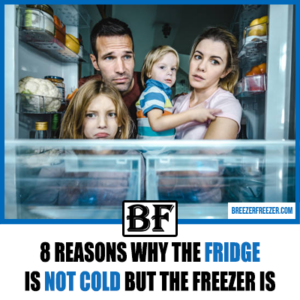
The reason behind your fridge’s lack of coldness while the freezer remains functional can be attributed to various factors. These include incorrect temperature settings, either overstocking or understocking the fridge, insufficient clearance around the appliance, an unlevelled installation, a faulty or leaking door, dirty condenser coils, a stuck damper control, or even component failures.
Speaking of component failures, there are several parts within the refrigerator that can malfunction. These include elements of the defrost system such as the defrost heater, timer, thermostat, or control board, as well as the thermistor, evaporator fan motor, temperature control board, and main control board.
In this article, we will delve into the cooling issues that plague refrigerators and explore how to resolve them. We will also examine specific brands like GE and LG, as well as the side-by-side fridge configuration, which often experiences this particular problem.
Let’s begin our investigation!
Quick Troubleshooting Guide
| Likely Reason | Quick Fix |
| Incorrect Temperature Setting | Set the fridge temperature to 32°F – 40°F for optimal cooling. |
| Fridge Overstocking or Understocking | Load the fridge to approximately three-quarters full for proper airflow and circulation. |
| Lack of Clearance | Ensure a minimum clearance of 0.5 inches on the sides and at least 1 inch at the back of the fridge to allow for proper ventilation. |
| Unlevelled Installation | Adjust the fridge’s feet or use shims to level the appliance and ensure stability. |
| Leaky Door | Make sure to fully close the fridge door, remove any obstructions, and replace a defective door gasket if necessary. |
| Filthy Condenser Coils | Follow the manufacturer’s instructions to clean the condenser coils and remove any accumulated dirt or debris. |
| Stuck Damper Control | Attempt to manually unstick the damper control. If unsuccessful, seek assistance from a professional technician. |
| Component Failure | Inspect the defrost system, thermistor, evaporator fan motor, temperature control board, and main control board for any faults. Replace any faulty components accordingly. |
Troubleshooting: Why is My Refrigerator Warm While the Freezer is Cold?
If you’ve noticed that your refrigerator is not cooling properly while the freezer is working fine, there are several potential reasons for this discrepancy. Let’s explore the eight most common causes and their corresponding fixes:
Incorrect Temperature Setting
Refrigerators function optimally at temperatures between 32°F and 40°F, while freezers are designed to operate below 0°F. If your freezer is working well but the fridge is warm, it might indicate that the fridge’s temperature setting is slightly higher than it should be. Check the temperature controls and adjust them accordingly.
Fridge Overstocking or Understocking
It’s important to strike a balance when stocking your fridge. Overloading it beyond ¾ of its capacity or understocking it below ½ can disrupt proper airflow and hinder the cooling process. Reduce the load if it’s overcrowded or increase it if it’s understocked. Aim for a ¾ full fridge to allow for optimal air circulation.
Insufficient Clearance
Proper airflow is crucial not only inside the fridge but also around its exterior. If the refrigerator is positioned too close to walls or objects, it can impede air circulation and affect cooling efficiency. Consult your manual to determine the recommended clearance, usually at least ½ inch on the sides and 1 inch at the back.
Unlevelled Installation
For the fridge to cool effectively, it must be placed on a level surface. An uneven installation can prevent the door from closing properly, leading to the escape of cold air and the entry of warm air. Adjust the refrigerator’s feet to achieve a level position, and consider using shims if needed.
Leaky Door
If the fridge door fails to close tightly, cold air will escape, and warm air will enter, resulting in poor cooling. Ensure that the door is shut firmly and remove any obstructions hindering proper closure. Clean the door seal to remove dirt, and if the seal is damaged or worn out, replace it.
Filthy Condenser Coils
Condenser coils play a crucial role in cooling the fridge, but they can accumulate dust, grease, and pet dander, hindering their effectiveness. Consult your fridge manual for instructions on cleaning the condenser coils, as the process may vary by brand. Vacuum or brush off the coils regularly, ideally every 2-3 months.
Stuck Damper Control
The damper control regulates the flow of cold air into the refrigerator. If it becomes stuck, it can restrict the airflow and prevent the fridge from cooling properly. Inspect the damper control and try to manually reposition it if it’s stuck. If the problem persists or the component is damaged, seek professional assistance.
Component Failure
Various components within the refrigerator can malfunction and impact its cooling ability. These include elements of the defrost system (defrost heater, timer, thermostat, control board), thermistor, evaporator fan motor, temperature control board, and main control board. If all other troubleshooting steps fail, consider contacting a professional to diagnose and replace any faulty components.
Troubleshooting: GE Fridge Not Cooling But Freezer Works
If you’re experiencing a situation where your GE fridge is not cooling, but the freezer is operating correctly, there are several possible reasons for this issue:
Understocked or Overstocked Refrigerator
An improperly stocked fridge can affect its cooling ability. Avoid overloading it or leaving it too empty. Maintain a balance, keeping the fridge approximately ¾ full for optimal cooling.
Dirty Condenser Coils
Accumulated dirt on the condenser coils can impede cooling performance. Regularly clean the coils to ensure efficient heat dissipation.
Incorrect Fridge Temperature Setting
Check the temperature setting of your fridge. If it is set higher than 40°F (4°C), adjust it within the recommended range of 32°F to 40°F (0°C to 4°C) for proper cooling.
Stuck or Damaged Damper Control
The damper control regulates the airflow between the freezer and the fridge compartments. If it is stuck or damaged, it can disrupt the cooling process. Examine the damper control and repair or replace it as necessary.
Door Leakage
Leaky doors can allow warm air to enter the fridge, preventing it from cooling effectively. Ensure that the refrigerator is properly leveled, and clean or replace the door seal if it is dirty or defective.
Defrost Failure
If the defrost system malfunctions, frost can accumulate on the evaporator coils and hinder cooling. Check the defrost unit components, such as the defrost heater, defrost timer, defrost thermostat, and defrost control board, for faults and replace any faulty parts.
Defective Components
Faulty components, including the thermostat, evaporator fan motor, thermistor, temperature control board, or main control board, can impact cooling performance. Consult a professional to diagnose and replace any defective parts.
Troubleshooting: LG Fridge Not Cooling But Freezer Works
If your LG fridge is not cooling adequately while the freezer remains cold, consider the following potential causes:
Excessively Loading or Understocking the Fridge
Similar to other refrigerators, overstocking or understocking the fridge can disrupt proper airflow and affect cooling efficiency. Maintain an optimal food load for consistent cooling performance.
Unlevelled Installation
An unlevelled installation can lead to air leakage through the door, compromising cooling effectiveness. Ensure that the fridge is properly leveled to prevent this issue.
Dirty Condenser Coils
Regularly clean the condenser coils to remove accumulated dirt, which can impede heat dissipation and cooling efficiency.
Incorrect Temperature Setting
Verify that the temperature setting of the fridge is within the recommended range (32°F to 40°F or 0°C to 4°C) for efficient cooling.
Failed Defrost System
A malfunctioning defrost system can cause frost to accumulate on the evaporator coils, hindering cooling. Check the defrost components and replace any faulty parts as needed.
Stuck Damper Control
Inspect the damper control and ensure it moves freely. If it is stuck, it may disrupt the airflow and require repair or replacement.
Failed Thermistor, Evaporator Fan Motor, Thermostat, Temperature Control Board, or Main Control Board
Consult a professional to diagnose and address any issues with these components that could be affecting the fridge’s cooling performance.
Troubleshooting: Side-by-Side Refrigerator Not Cooling Properly While Freezer Works
If you have a side-by-side refrigerator that is not cooling as expected while the freezer remains in good working condition, the issue can typically be attributed to one or more of the following factors:
Incorrect Refrigerator Temperature Setting
Ensure that the temperature setting for the refrigerator compartment is within the recommended range of 32°F to 40°F (0°C to 4°C). Setting it higher than this range can result in inadequate cooling.
Poor Food Stocking
Properly balance the food load in the refrigerator. Overstocking or understocking can obstruct airflow and impede cooling performance. Aim for a refrigerator that is around 75% full for optimal cooling efficiency.
Insufficient Clearance Around the Fridge
Maintain adequate clearance for proper ventilation. Make sure there is at least 1 inch of space at the back of the refrigerator and a minimum of 0.5 inches of clearance on the sides.
Dirty Condenser Coils
Regularly clean the condenser coils to remove accumulated dirt and debris. Dirty coils can restrict heat dissipation and hinder cooling performance.
Stuck Damper Control
Inspect the damper control, which regulates the airflow between the freezer and refrigerator compartments. If it appears stuck or obstructed, it may be impeding the cooling process. Attempt to free the damper control if possible.
Failing Defrost System
Check the components of the defrost system for any malfunctions. A faulty defrost system can lead to excessive frost buildup on the evaporator coils, affecting cooling efficiency. Seek professional assistance to diagnose and address any issues with the defrost system.
Failing Temperature Control Board or Thermostat
A malfunctioning temperature control board or thermostat can disrupt the cooling process. Consult a professional to inspect and replace any faulty components.
Leaky Fridge Door
Ensure that the refrigerator door is closing properly without any gaps. Leaks in the door seal can allow warm air to enter, causing inadequate cooling. Replace the door seal if it is damaged or defective.
Unlevelled Unit
Check the refrigerator’s levelness. An unlevelled unit can prevent the door from closing tightly, leading to cooling issues. Adjust the fridge’s feet or use shims to achieve proper leveling.
In summary, to fix a side-by-side refrigerator with a warm fridge and a cold freezer, follow these steps:
- Adjust the refrigerator temperature setting to the recommended range.
- Balance the food load in the fridge.
- Maintain sufficient clearance around the refrigerator.
- Ensure the fridge door closes properly and replace a faulty door seal if necessary.
- Clean the condenser coils regularly.
- Unstick the damper control if it appears stuck.
- Seek professional assistance to check and repair the defrost system, temperature control board, thermostat, and other components if needed.
Conclusion
There are several possible reasons why a refrigerator may not be cold while the freezer functions properly. It’s important to consider factors such as incorrect temperature settings, overstocking or understocking, insufficient clearance around the refrigerator, improper installation, door leakage, dirty condenser coils, stuck damper control, or component failures.
When addressing failed components, it is crucial to pay attention to the defrost system, thermostat, temperature control board, thermistor, evaporator fan motor, and main control board. These components play vital roles in the cooling process and can impact the overall performance of the refrigerator.
By identifying and resolving these issues, you can restore proper cooling functionality to your refrigerator and ensure that both the fridge and freezer compartments are working optimally.
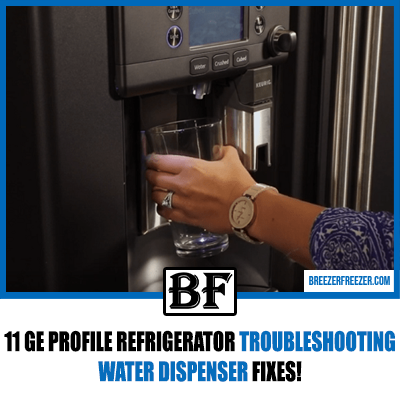
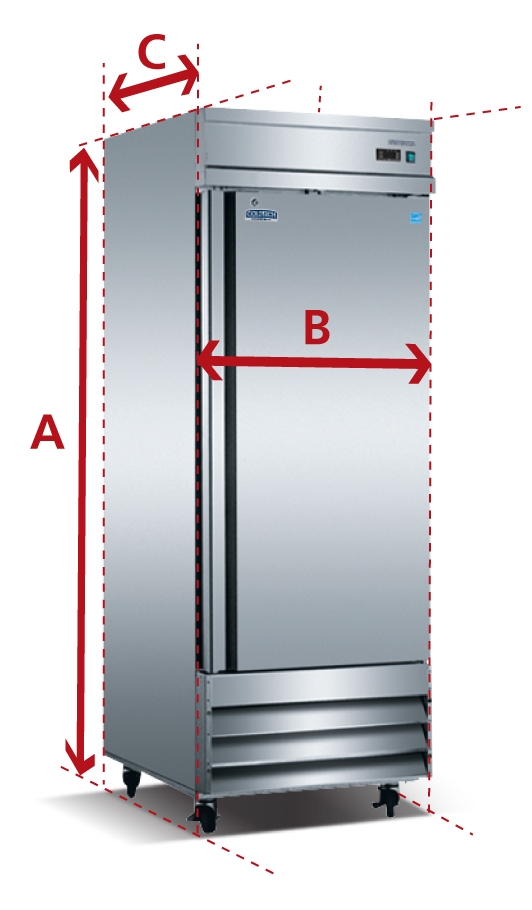
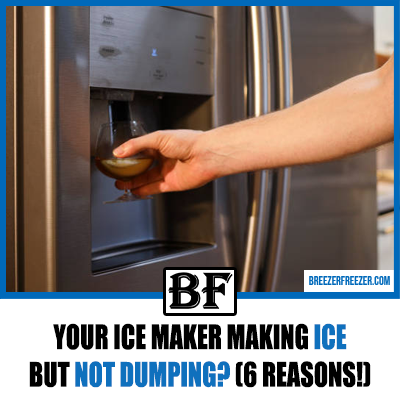

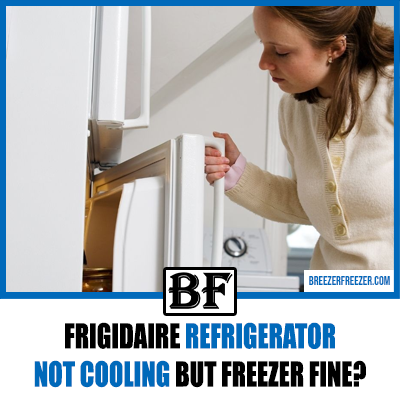
![How Long Is Cake Good For in The Fridge? [Quick Answer!]](https://breezerfreezer.com/wp-content/uploads/2023/10/How-Long-Is-Cake-Good-For-in-The-Fridge.png)